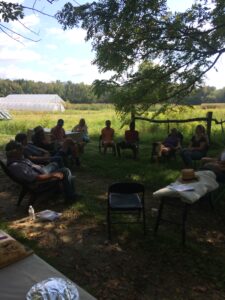Final report for FNC16-1025
Project Information
That Guy's Family Farm raises six acres of certified organic produce in southwest Ohio. We have been certified organic for 20 years. We sell a wide range of produce year-round at farmer's market, our farmstand, through Farm Share subscriptions and two wholesale accounts.
We finished the first year of our two year project. We purchased and built a 24X48 high tunnel in the spring of 2016. The transplants from seed were started on 05/18/16. The suckers were gathered from the same varieties from field plants and planted in cell trays on 06/24/16 (five weeks later). The soil in the tunnel was prepared and drip tape installed. The seeded and suckered tomato transplants were planted in the tunnel on 07/11/16. The tomato plants were watered, strung, and weeded for the duration of the season. Fruit harvest began on 08/08/16 and continued until a killing frost on 11/11/16. Visual observation, projected timeline was met, and yields records were kept.
The conclusion of the second year comfirmed our project objectives. We were comfortable with the process of collecting suckers from the main season crop (07-02-17) and how to maintain the vitality of the suckers until transplanting. The timing of seeding the control group (5-24-17) to match plant growth of both transplant groups seemed correct. The soil was prepared and spacing of the beds and tranplants was agreed to be left the same. The tomatoes were planted on 7-17-17 after rain delays. This season did come with record rainfall for June and July. We were especiallly glad to have this late season crop under cover of a tunnel. The tomatoe plants were watered, strung, and weeded for the duration of the season. Fruit harvest began on 08/31/17 and continued until a killing frost on 10/21/17. Visual observation, projected timeline was met, and yields records were kept.
We met our objective of setting up the research using the high tunnel to produce late season tomatoes using suckers as plants. We followed the timeline and used the specific methods outlined in the solution in the grant. We believe that affordable, certified organic tomato plants for fall production can be produced using side shoots (suckers) that are pruned from main season tomato plants.
We proposed a trial of organic late season tomatoes produced via transplanted suckers.
This project has two specific sub-goals:
Measure potential yield differences between the plants produced via suckers and late season tomato transplants grown from seed.
Calculate the economic implications of each production system by accounting for any observed yield differences and variations in labor hours.
Specific methods follow:
Tomato plants grown via suckers were the experimental treatment, while tomato plants grown from seed served as controls.
At least 80 tomato plants will be produced in the experimental treatment, with an equal number being produced in the control treatment.
- All tomato plants in both treatments were transplanted into a high tunnel to control for environmental factors, to prevent fungal disease, and to insure that the fall crop is able to produce as long as possible.
Suckers were pruned from main season tomato plants and rooted during late-June. The control plants will be started from seed during mid-May to ensure that both groups of plants are roughly the same size when planted in the high tunnel during early July.
All transplanting and harvest activities did occur on the same day for both control and experimental tomatoes.
Crop yields (weight) and labor hours were tracked for both groups throughout the growing season, and will be assigned a monetary value at the end of the season. This data was used to compare the profitability of organic late season tomato plant production via suckers to traditional plant production via seeds.
Cooperators
Research
The main goal of this project is to evaluate the economic implications of using suckers to produce late season tomato plants instead of starting late season plants from seed. We will measure yield differences between the plants produced via suckers and plants grown from seed by weighing the marketable fruits from each group after each harvest. Labor hours needed to produce both types of plants will be tracked throughout the growing season, and will be assigned a monetary value at the end of the season. Tomato yields from both groups will also be assigned a monetary value. These data will be used to compare the profitability of organic late season tomato plant production via suckers to traditional plant production via seeds. We believe that plants produced from suckers will increase the profitability of growing late season tomatoes and can lead to greater financial sustainability for farmers.
Impacts
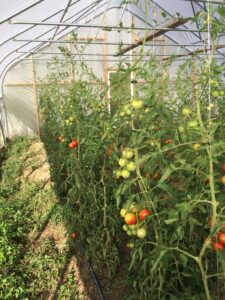 The outcome is what we had hoped to see. This is the average over the 2 year growing season. The suckered tomato transplants used 19.5 less hours of labor to produce and 5 less weeks of seedling care during our busiest time of the year with less worries. The 19.5 hours equaled $390 in labor savings. The suckered tomatoes also yielded 21% more fruit overall which equalled $368 in additional income in those 2 seasons. We are surprised at the increase in yield and attribute this to earlier harvest of fruit by one week or more. We also harvested tomatoes from the high tunnel for 8 additional weeks, extending the season from our field grown tomatoes. All tomatoes were beautiful and disease free from being in the controlled environment of the high tunnel.
The outcome is what we had hoped to see. This is the average over the 2 year growing season. The suckered tomato transplants used 19.5 less hours of labor to produce and 5 less weeks of seedling care during our busiest time of the year with less worries. The 19.5 hours equaled $390 in labor savings. The suckered tomatoes also yielded 21% more fruit overall which equalled $368 in additional income in those 2 seasons. We are surprised at the increase in yield and attribute this to earlier harvest of fruit by one week or more. We also harvested tomatoes from the high tunnel for 8 additional weeks, extending the season from our field grown tomatoes. All tomatoes were beautiful and disease free from being in the controlled environment of the high tunnel.
We are encouraged and excited to continue, and feel this can help sustainable farmers extend the growing season with less upfront time needed to produce viable transplants.
Accomplishments
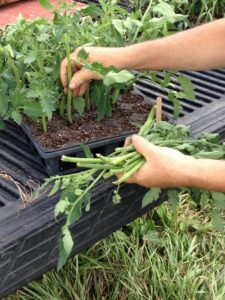
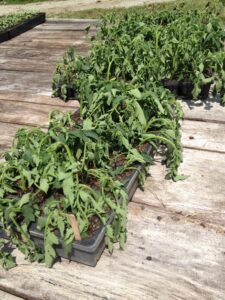
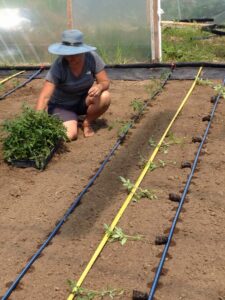
We wanted to use varieties that are used in field production in the research since that is what will be available to most farmers using this method of producing transplants. Three varieties were chosen, Fourth of July, Big Beef, and Arkansas Traveler. We found implementing 3 varieties was easy enough to collect data on, and provided additional data on variety selection for the second year and in the future. We found the 2 hybrids performed better than the heirloom variety; we selected Green Zebra for 2017 to replace Arkansas Traveler.
We want to note the condition of the suckers when first potted up -- they will wilt for a few days before they take root and rebound. This seems normal and still results in a healthy transplant in 2 weeks. The size and maturity comparison of both sucker transplants and the seeded control group were equal at time of planting. This was only an estimate that proved accurate.
The estimated labor hours stand as projected. We are thinking the hours will be less in 2017 because some labor hours were used to build the high tunnel and amend the soil. Now, the system is in place and we should see labor hours decrease. However, hosting the educational outreach and activities did require prep and planning, but has kept us within our projected goal.
The only pests we had to monitor for were the tomato horn worm and army worm. We controlled these by hand picking from plants while stringing and harvesting. We believe yield wasn’t affected.
The evaluation of tranplants produced from suckers did increase profitability, reduced the time and resources needed and created a late season crop that had environmental, economic, and social benefits for the farm, farmers and customers. This forward thinking using traditional wisdom of the past can lead to greater financial sustainability for farmers.
Educational & Outreach Activities
Participation Summary:
We offered a farm tour featuring our grant proposal on 9-17-17. This event was publicized through Ohio Ecological Food and Farm Association (OEFFA) Direct email alerts and with Clinton County Extension agent, Tony Nye. Tony highlighted the tour in his weekly column in the Wilmington News Journal. He gave a brief history of NCR-SARE, our farm, and the grant proposal. It was a hot afternoon, and we toured the tomato crop and circled in shade for refreshments and disscusion about our experience to date.
We hosted 2 of Southern State Community College's agriculture classes on 10-16-17, accompanied by instructors Anna Benton and Tom Smith. This was a engaging group of students with few experiences on a certified organic farm. The tomato production presentation served to begin a lively dialog about the possiblilities of generating income on limited acres.
Most recently we presented the grant proposal to the Little Miami Chapter of OEFFA on 01-21-18. We had 2 farmers with high tunnels present that are interested in this production method. We plan to continue using suckers for late season tomato production and can advise those interested.
We also kept our CSA and farmers market customers updated on this project through our annual newsletter, conversations with customers and wholesale clients, and our weekly blog to CSA share members.
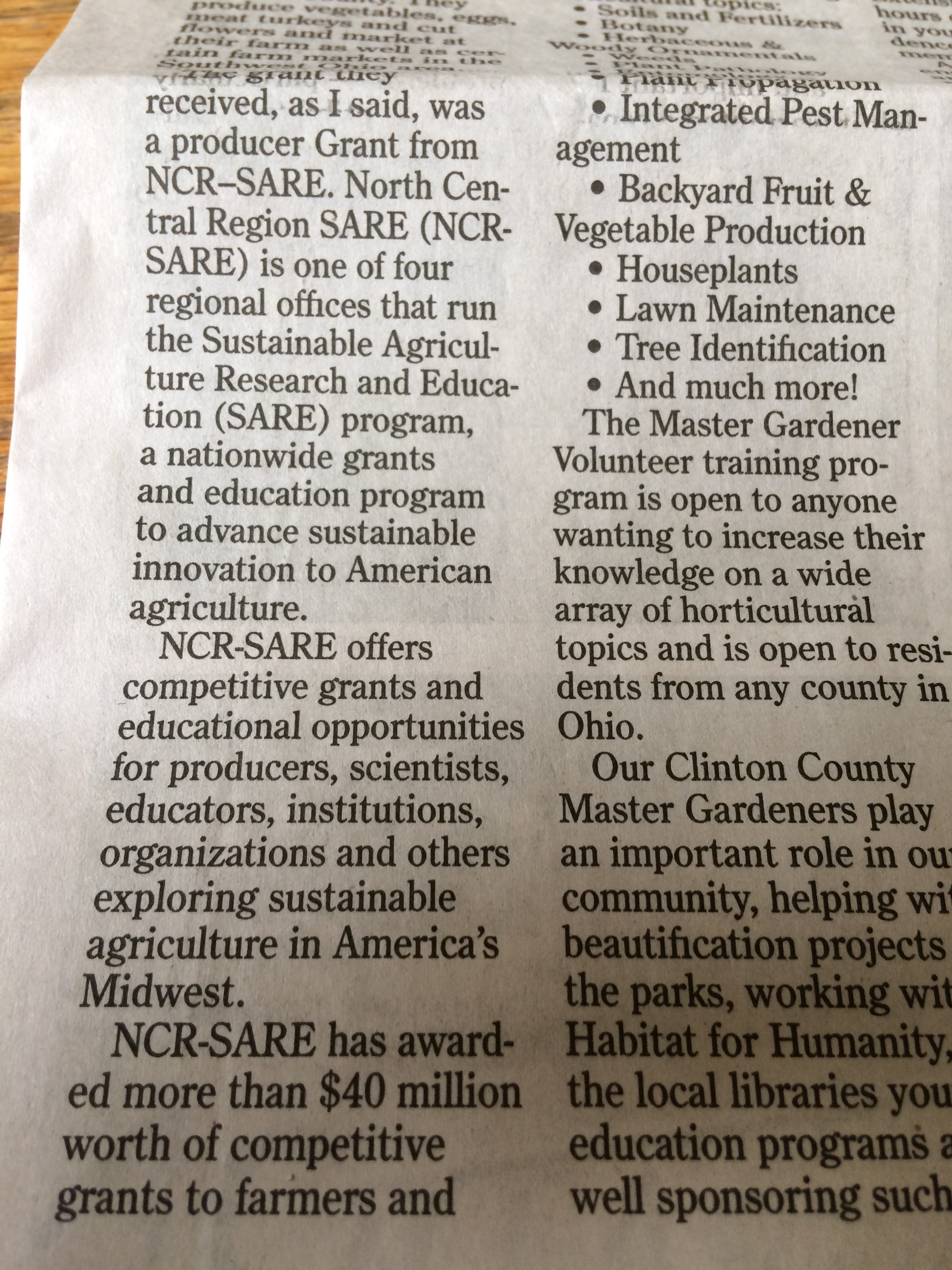
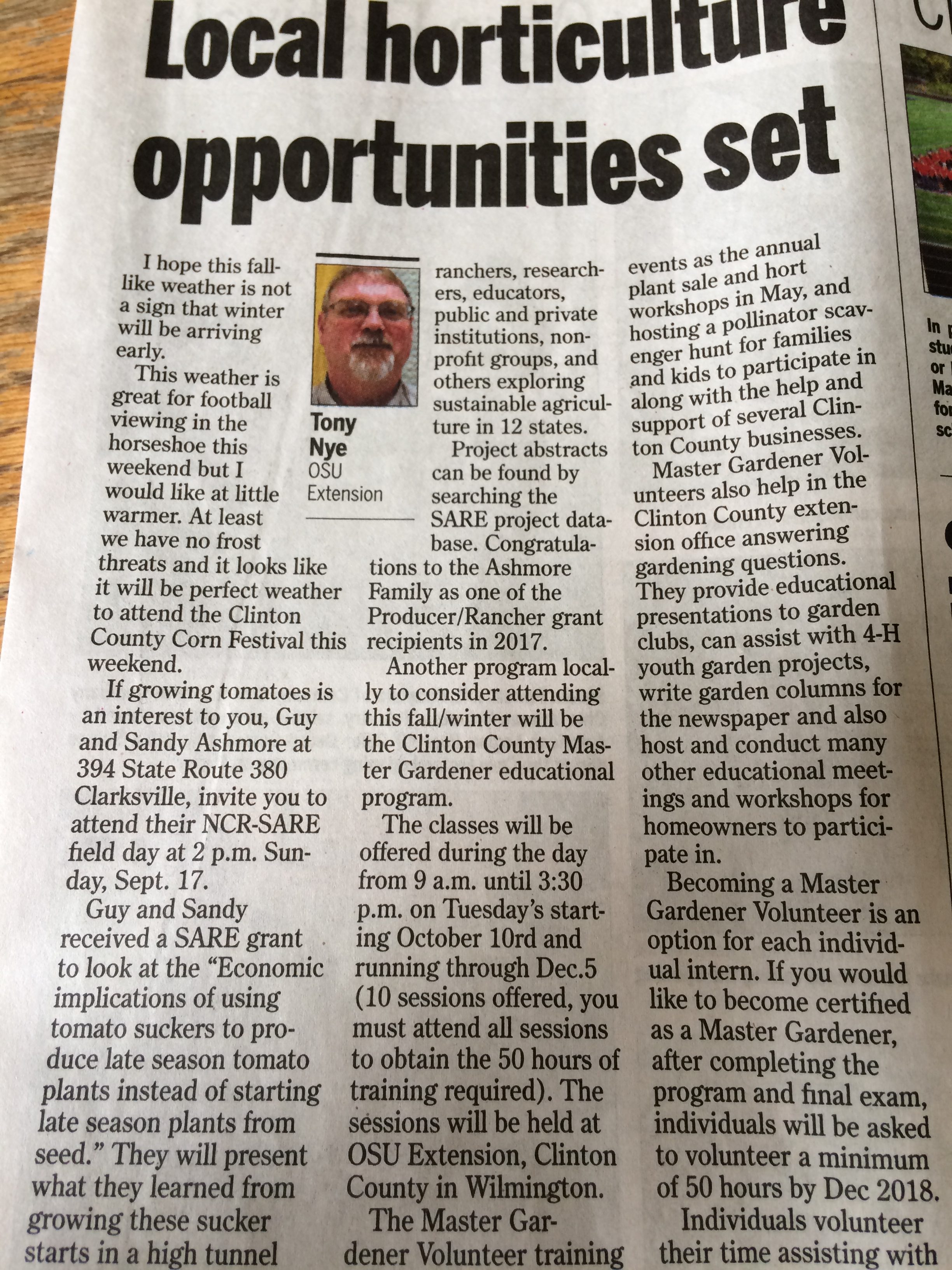
Learning Outcomes
We believe affordable, certified organic tomato plants for fall production can be produced using side shoots (suckers) from main season tomato plants in the field. The purpose of this project is to evaluate the economic implications of using suckers to produce late season tomato plants instead of starting plants from seed.
We produce vegetables year round on our farm, and work to extend the growing season of each crop we produce. Over the past few years we have found that late season tomatoes (ripening after Labor Day) are popular with our customers. However, we struggle to grow the tomato seedlings needed for fall production due to the labor required to care for seedlings during our busiest months of the year. As farmers working to produce six acres of vegetables with limited labor and limited mechanization, we must work with utmost efficiency in order to keep our cost of production down. Spending six weeks in May and June seeding flats (for early July field planting), maintaining correct germination and growing temperatures, and monitoring water levels of tomato seedlings takes precious labor time away from the myriad of other duties our farm staff must carry out during our busiest months. As a result, we have found that our fall tomato seedling production suffers during this time period. Certified organic tomato plugs are not locally available in our area during July, and mail order certified organic plugs are prohibitively expensive. Farmers in the North Central region can charge a premium for late season tomatoes, but many farmers do not attempt to grow tomatoes for fall production due to the unavailability of affordable organic plugs during early July.
It works! We have found this to be a viable, time saving, easy, and ecomonical way to produce late season tomato transplants! As a bonus we have found an increase in yields in the plants started from suckers along with ripening up to a week sooner. We will continue this production model in the future as nothing presented itself as a disadvantage at any stage during the season.
We will use this method of producing transplants for late season tomato crops in a high tunnel. Also, we will implement the use of this method to produce a second mid season field crop of tomatoes because it worked so well. We are already suckering the first crop for production performance, so it would easy to generate that second set of tranplants. This second crop could keep us ahead of disease that might affect the first planting.
If you begin to look at high tunnel tomato production using varieties specific to high tunnel production it would be above the scope of this project. This proposal only used the high tunnel for season extension. To take this proposal to the next level would be to maximize high tunnel production practices and use suckers from main season high tunnel plant varieties. We are proficient growing tomatoes in high tunnels, but with more management and better practices we think yields and the amount of weeks available to harvest would increase.
We experienced many AhHa moments as we presented this production method to our peer groups, just as we had happened to us when a customer at farmer's market explained how his grandfather used suckers to produce transplants. AhHa we said, and tried it on a small scale for a few years. This make too much sense not to continue as a true production practice. This grant has given us the motivation and knowledge to implement this almost forgotten method year in and year out. The need to pass down traditional agricultural practices needs to be at the forefront before it is lost from generations to come.
Project Outcomes
1. If you begin to look at high tunnel tomato production using varieties specific to high tunnel production it would be above the scope of this project. This proposal only used the high tunnel for season extension. To take this proposal to the next level would be to maximize high tunnel production practices and use suckers from main season high tunnel plant varieties. We are proficient growing tomatoes in high tunnels, but with more management and better practices we think yields and the amount of weeks available to harvest would increase.
2. This has the implications of simply producing a second mid-season field crop. During the process of suckering the first crop for production performance reasons, suckers could be collected for the next planting. This could potentially keep the farmer ahead of diseases that might set in on the first crop. The collection of suckers would begin as soon as they are formed, then 2 weeks for tranplants to grow and the second crop could be planted within 2-3 weeks of the first crop, keeping you within the frost date and extend harvest weeks.
